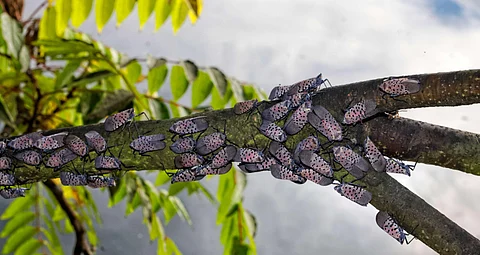

There has been a 'silent killer' on the prowl for decades, which is now threatening global biodiversity. We are talking about hundreds and thousands of invasive alien species that are overwhelming the natural species across the world.
India, which is mega-diverse and home to four of the global biodiversity hotspots, is the second worst-affected country after the US. Last week in Bonn, Germany, representatives of 143 member States of the Intergovernmental Platform on Biodiversity and Ecosystem Services (IPBES) approved a new report, which stated that more than 37,000 alien species have been introduced by many human activities in regions and biomes around the world. Of these, 3,500 alien species seriously threaten nature and contribute to 60% of recorded global animal and plant extinctions.
The new report is the most comprehensive assessment ever carried out on invasive alien species around the world. It has been four years in development by 86 experts from 49 countries, drawing on more than 13,000 references.
What is startling is the global economic cost of these invasive exceeds $423 billion annually, which is more than the global annual cost estimate for natural disasters. It has at least quadrupled every decade since 1970 and is only going to worsen. On mitigation efforts, the report says 80% of countries have targets related to managing invasive alien species in their national biodiversity plans, but only 17% have national laws or regulations specifically addressing these issues.
As for India, the report had only one reference about the spread of Caribbean false mussels damaging locally important fishery resources in Kerala. The problem is much bigger and severe.
In another recent study published in Biological Invasions, 330 species were declared invasive out of more than 2,000 alien species found in India and cost the country $127.3 billion to $182.6 billion from 1960-2020. The report analysed 112 countries. The top five nations incurring maximum economic loss due to the invasives were the US, Australia, Brazil, China and India.
Tanaya Nair, member of Biodiversity Collaborative Research Student, University of Oxford and Visiting Researcher, University of Witwatersrand, says, "Recent studies predict that nearly half of India's total area is vulnerable to invasion by alien plant species, posing significant threats to agriculture and national security. Data from the field suggests that 76% of all Indian forests are already invaded by multiple invasive alien plant species." She said the impact on the environment is felt through multiple interconnected pathways.
For example, the shola-grassland mosaics of the upper Nilgiris in Tamil Nadu serve as catchment areas for high-elevation streams that flow into the Bhavani river. Here, large tracts (~25%) of native grassland have already been lost to invasions by woody invasive plants like Wattle which exert a greater demand on the water table, and in turn, alter the water flow and flood regulation that many communities depend on.
The developed world tends to assess the effects of Invasive Alien Species using economic cost models. However, in the Indian context, where significant populations rely on natural resources, it might be more relevant to consider their impact in terms of the disproportionate effect on livelihoods. "Invasive species affect local communities by affecting their health, safety and cultural attachment to native landscapes. For instance, Prosopis invasion has blocked migratory routes in the Rann of Kutch, reducing access to water sources and has also led to conflicts among pastoralists over reduced grazing resources," Nair said.
Dr Vinod B Mathur, former chairperson, National Biodiversity Authority of India and IPBES management committee that guided the latest assessment, told The New Indian Express that invasive species are growing at an unprecedented rate, unlike ever before. It is recognised as one of the five major direct drivers of change in nature globally, alongside land-and-sea-use change, direct exploitation of organisms, climate change and pollution.
"India being one of the 17 mega biodiverse countries of the world is facing negative impacts in varying dimensions. It is estimated that Lantana camara, a plant invasive species, has invaded 38.8% forests of India, particularly degraded forests of hot and humid areas. Lantana is widely distributed across landscapes with maximum invasion in fragmented dry deciduous forests of Central India, Shivalik Hills and Southern Western Ghats. Lantana is probably the most widely distributed invasive plant in India, as compared to other invasive plants," Mathur said.
Tamil Nadu shows the way forward
Tamil Nadu, including the Western Ghats, is among the chief invasion hotspots in the country. A compendium of plants of Tamil Nadu recorded a total of 6,723 taxa (species), of which 2,459 are non-native alien species, comprising nearly 36.6% of the state’s flora.
As per an official report, the area under five major invasive alien species alone is estimated to be 2,68,100 hectares (ha). The Lantana camara was found in 1,85,000 ha, Prosopis juliflora (56,000 ha), Acacia mearnsii (wattle, 22,400 ha), Senna spectabilis (2,400 ha), and Opuntia sp. (2,300 ha).
Additional Chief Secretary Supriya Sahu told The New Indian Express, "Chief Minister M K Stalin had made removal of invasives a priority and Tamil Nadu is the first state to have a dedicated invasive species removal policy. Tamil Nadu Newsprint and Papers Limited has been roped in to remove the invasive trees and use the wood for manufacturing paper. So far, we have removed invasives from 4,185 hectares."
Need for national-level policy
Mahesh Sankaran, Professor, National Centre for Biological Sciences, said a request was made to the Centre to frame a policy on invasive species management, but that hasn't happened yet. In India, when someone spots invasive alien species, nobody is able to identify it. "Our biosecurity measures are weak. For instance, the customs office at airports rarely checks if anyone is carrying plants that can carry the risk of invasive species."